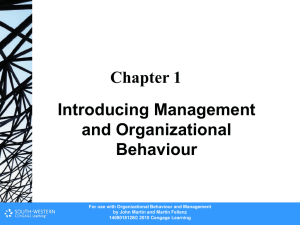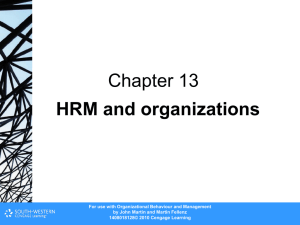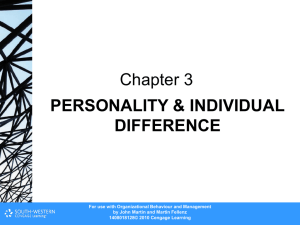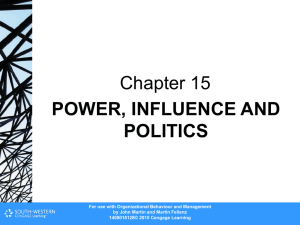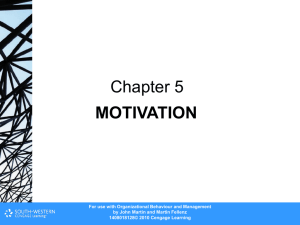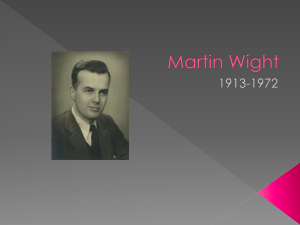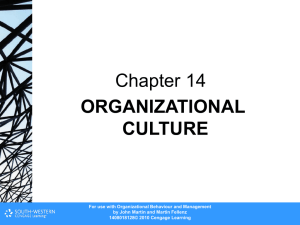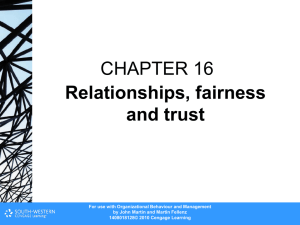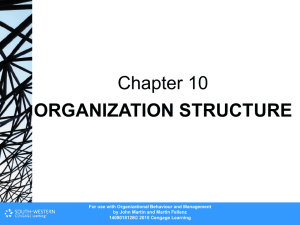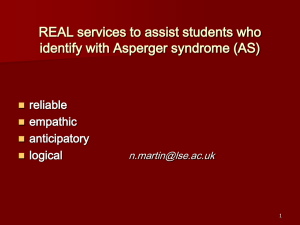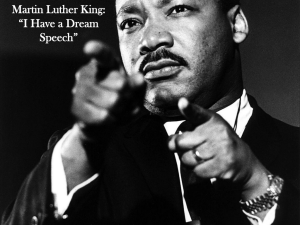Control - Cengage Learning
advertisement
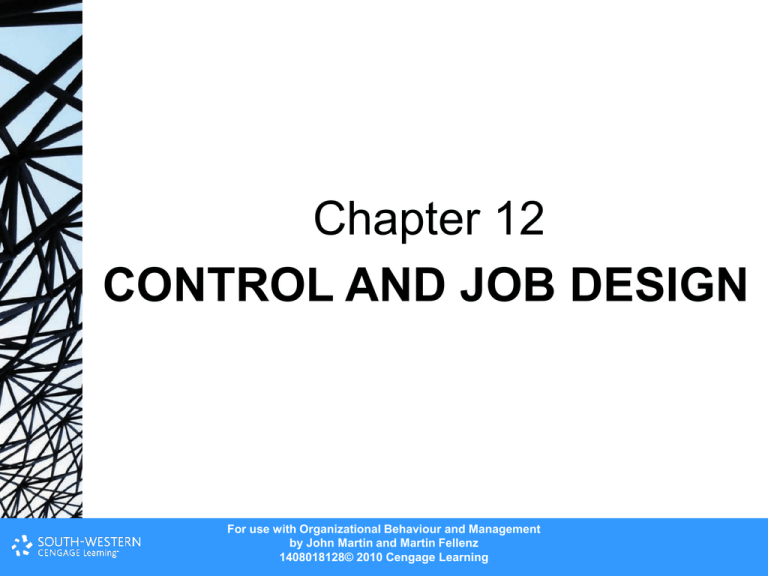
Chapter 12 CONTROL AND JOB DESIGN For use with Organizational Behaviour and Management by John Martin and Martin Fellenz 1408018128© 2010 Cengage Learning Control • Control - the function of regulating events, actions, outcomes, or other relevant aspects according to preferred standards, plans, objectives, or other chosen referents For use with Organizational Behaviour and Management by John Martin and Martin Fellenz 1408018128© 2010 Cengage Learning Control Figure 12.1 • This basic model is called the negative feedback loop because it reduces discrepancies For use with Organizational Behaviour and Management by John Martin and Martin Fellenz 1408018128© 2010 Cengage Learning TOTE model Figure 12.2 For use with Organizational Behaviour and Management by John Martin and Martin Fellenz 1408018128© 2010 Cengage Learning TOTE model Figure 12.3 For use with Organizational Behaviour and Management by John Martin and Martin Fellenz 1408018128© 2010 Cengage Learning Control The necessary elements of control in any context are: • The goal - desired state • Feedback - relevant information about the current state • Discrepancy detection - comparison of the desired and actual states • Action - initiated to reduce any detected discrepancy Discrepancy amplifying loops - positive feedback loops also exist For use with Organizational Behaviour and Management by John Martin and Martin Fellenz 1408018128© 2010 Cengage Learning CONTROL IN ORGANIZATIONS • Prospective control - proactive alignment of resources in ways that maximize the likelihood of achieving intended objectives • Reactive control - actions taken to bring activities in line with targets and expectations • Authority - legitimate power vested in managers based on their position and role in an organization For use with Organizational Behaviour and Management by John Martin and Martin Fellenz 1408018128© 2010 Cengage Learning Control in organizations Two often opposing aspects to the existence of control: • Basis of order and predictability in operational activity • Control is restrictive, lacks flexibility, and can be manipulative and greedy with regard to the abolition of personal freedom Huczynski and Buchanan (1991) control has a number of connotations: • Physical • Economic • Psychological A fourth connotation is that of: • Political perspectives For use with Organizational Behaviour and Management by John Martin and Martin Fellenz 1408018128© 2010 Cengage Learning APPROACHES TO ORGANIZATIONAL CONTROL • Ouchi (1979, 1980) three organizational control strategies bureaucratic control, market control, and clan control • Use determine by: – performance ambiguity which refers to the ease and clarity with which the value of activities or outcomes can be assessed – Goal incongruence, the second factor, is the degree of alignment between individual and organizational goals • Bureaucratic control - based on bureaucratic organizational forms • Market control - used at the unit level and based on profit/cost centres • Clan control - based on social influence on behaviour For use with Organizational Behaviour and Management by John Martin and Martin Fellenz 1408018128© 2010 Cengage Learning Ouchi’s organizational control strategies Table 12.1 For use with Organizational Behaviour and Management by John Martin and Martin Fellenz 1408018128© 2010 Cengage Learning Control – other perspectives • Panoptic control - based on prison design which allows all inmates to be observed without them being aware when it actually takes place • Concertive control - based on the social control exercised by groups on their members • Output control - direct measurement of the outputs produced • Behavioural control - direct observation during work performance • Input control (or clan control) – used where work outcomes are not measurable and where work performance cannot be observed • Paradox of control - control can lead to unintended consequences particularly in ethical decision For use with Organizational Behaviour and Management by John Martin and Martin Fellenz 1408018128© 2010 Cengage Learning MEANS OF ORGANIZATIONAL CONTROL • • • • • • • Managerial and supervisor behaviours Skill Organizational structure Hierarchy and authority Social control and socialization Technology Reward, punishment and reinforcement For use with Organizational Behaviour and Management by John Martin and Martin Fellenz 1408018128© 2010 Cengage Learning Informal supervisory control behaviours Table 12.2 For use with Organizational Behaviour and Management by John Martin and Martin Fellenz 1408018128© 2010 Cengage Learning MEANS OF ORGANIZATIONAL CONTROL • Clegg and Dunkerley (1980) – Vicious cycle of control – the downward spiral of tighter control leading to negative employee behaviours leading to tighter control Figure 12.4 For use with Organizational Behaviour and Management by John Martin and Martin Fellenz 1408018128© 2010 Cengage Learning Technology and control Table 12.3 For use with Organizational Behaviour and Management by John Martin and Martin Fellenz 1408018128© 2010 Cengage Learning Behaviour modification Figure 12.5 For use with Organizational Behaviour and Management by John Martin and Martin Fellenz 1408018128© 2010 Cengage Learning Job design • Job design - the way in which tasks are grouped, assigned and structured in organizations at the level of individual jobs For use with Organizational Behaviour and Management by John Martin and Martin Fellenz 1408018128© 2010 Cengage Learning Work study • Scientific management • One best way • Division of labour •Work study • Method Study • Work measurement For use with Organizational Behaviour and Management by John Martin and Martin Fellenz 1408018128© 2010 Cengage Learning Work Study Figure 12.6 For use with Organizational Behaviour and Management by John Martin and Martin Fellenz 1408018128© 2010 Cengage Learning Ergonomics A multi-disciplinary approach to considering how people can best conduct specific work tasks, including: • The human-machine interface • Maximal efficiency with minimal effort and stress • Athropometric profiles of human beings • Physiology and biomechanics For use with Organizational Behaviour and Management by John Martin and Martin Fellenz 1408018128© 2010 Cengage Learning Job analysis Two main approaches to job analysis: • Functional job analysis: •Employee activities relevant to data, people and other jobs. •The methods and techniques used by the worker. •The machines, tools and equipment used by the worker. •What outputs are produced by the worker. • Position analysis questionnaire: • Sources of information necessary to the job. • Decision making associated with the job activity. • Physical aspects associated with the job. • Interpersonal and communication necessary to the job. • Working conditions and their impact on the job. • Impact of work schedules, responsibility etc. For use with Organizational Behaviour and Management by John Martin and Martin Fellenz 1408018128© 2010 Cengage Learning Job analysis and job effectiveness Figure 12.7 For use with Organizational Behaviour and Management by John Martin and Martin Fellenz 1408018128© 2010 Cengage Learning Job analysis • Job analysis is used to support activities such as: • Resourcing and HR planning • Training • Career development and succession planning • Payment and remuneration level • Provision of job descriptions and job evaluation schemes • Performance evaluation For use with Organizational Behaviour and Management by John Martin and Martin Fellenz 1408018128© 2010 Cengage Learning Approaches to designing jobs Simplification and job engineering Job rotation Job enlargement Job enrichment Hackman & Oldham’s model: • Skill variety • Task identity • Task significance • Autonomy • Feedback The model applies only to individuals that have high growth-need strength – those with an intrinsic interest in developing themselves, learning new and applying their existing skills, and taking responsibility and build identity through work For use with Organizational Behaviour and Management by John Martin and Martin Fellenz 1408018128© 2010 Cengage Learning Job characteristics approach to job enrichment Figure 12.8 For use with Organizational Behaviour and Management by John Martin and Martin Fellenz 1408018128© 2010 Cengage Learning Job Design Social-information processing model Salancik and Pfeffer (1978): • Recognizes the role of socially constructed reality of work • Highlights the role of social information in determining the effects of the design of a job on the holder • The way in which workers experience the nature of their job and subjectively interpret information about it • Such interpretations are influenced by others as well as by the past behaviour of the person themselves For use with Organizational Behaviour and Management by John Martin and Martin Fellenz 1408018128© 2010 Cengage Learning

